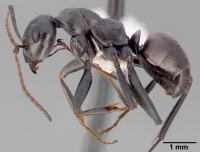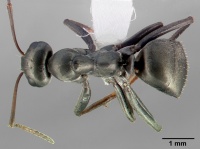Formica accreta
| Formica accreta | |
|---|---|

| |
| Scientific classification | |
| Kingdom: | Animalia |
| Phylum: | Arthropoda |
| Class: | Insecta |
| Order: | Hymenoptera |
| Family: | Formicidae |
| Subfamily: | Formicinae |
| Tribe: | Formicini |
| Genus: | Formica |
| Species: | F. accreta |
| Binomial name | |
| Formica accreta Francoeur, 1973 | |
| At a Glance | • Polygynous |
Identification
This is a black species with the metasternal process poorly developed. The gena is without coarse punctures, although poorly defined, elongate punctures are located just anterior to the eyes. The scapes are usually longer than the head length. The anterior border of the clypeus is angulate, the eyes are large (maximum diameter 0.43 - 0.54 mm). The ventral surface of the head, posterior border, dorsum of the mesosoma and dorsum of the petiole are without erect hairs. The first gastral tergite has only 3 or 4 short (> 0.1 mm), blunt hairs. The dorsal surfaces of the head and mesosoma are weakly shining. (Mackay and Mackay 2002)
Keys including this Species
- Key to Nearctic Formica fusca group males
- Key to Nearctic Formica fusca group queens
- Key to Nearctic Formica fusca group workers
Distribution
Western Canada south to California, east to Montana, south to New Mexico.
Latitudinal Distribution Pattern
Latitudinal Range: 65.508566° to 31.592321°.
| North Temperate |
North Subtropical |
Tropical | South Subtropical |
South Temperate |
- Source: AntMaps
Distribution based on Regional Taxon Lists
Nearctic Region: Canada (type locality), United States.
Distribution based on AntMaps
Distribution based on AntWeb specimens
Check data from AntWeb
Countries Occupied
| Number of countries occupied by this species based on AntWiki Regional Taxon Lists. In general, fewer countries occupied indicates a narrower range, while more countries indicates a more widespread species. |

|
Estimated Abundance
| Relative abundance based on number of AntMaps records per species (this species within the purple bar). Fewer records (to the left) indicates a less abundant/encountered species while more records (to the right) indicates more abundant/encountered species. |

|
Biology
Association with Other Organisms
 Explore: Show all Associate data or Search these data. See also a list of all data tables or learn how data is managed.
Explore: Show all Associate data or Search these data. See also a list of all data tables or learn how data is managed.
- This species is a host for the ant Polyergus mexicanus (a dulotic parasite) (Trager, 2013; de la Mora et al., 2021) (properly Polyergus umbratus).
- This species is a prey for the Microdon fly Microdon albicomatus (a predator) (Quevillon, 2018).
- This species is a prey for the Microdon fly Microdon cothurnatus (a predator) (Quevillon, 2018).
- This species is a prey for the Microdon fly Microdon piperi (a predator) (Quevillon, 2018).
Life History Traits
- Queen number: polygynous (Frumhoff & Ward, 1992)
Castes
Images from AntWeb

| |
| Worker. Specimen code casent0005358. Photographer April Nobile, uploaded by California Academy of Sciences. | Owned by UCDC, Davis, CA, USA. |
Nomenclature
The following information is derived from Barry Bolton's Online Catalogue of the Ants of the World.
- accreta. Formica accreta Francoeur, 1973: 182, figs. 308-323 (w.q.m.) CANADA. Junior synonym of fusca: Wheeler, G.C. & Wheeler, J. 1986g: 16. Revived from synonymy: Bolton, 1995b: 190.
Unless otherwise noted the text for the remainder of this section is reported from the publication that includes the original description.
Description
=Worker Morphology
 Explore: Show all Worker Morphology data or Search these data. See also a list of all data tables or learn how data is managed.=
Explore: Show all Worker Morphology data or Search these data. See also a list of all data tables or learn how data is managed.=
- Caste: weakly polymorphic
References
- Bolton, B. 1995b. A new general catalogue of the ants of the world. Cambridge, Mass.: Harvard University Press, 504 pp. (page 190, Revived from synonymy; revived status)
- Borowiec, M.L., Cover, S.P., Rabeling, C. 2021. The evolution of social parasitism in Formica ants revealed by a global phylogeny. Proceedings of the National Academy of Sciences 118, e2026029118 (doi:10.1073/pnas.2026029118).
- de la Mora, A., Sankovitz, M., Purcell, J. 2020. Ants (Hymenoptera: Formicidae) as host and intruder: recent advances and future directions in the study of exploitative strategies. Myrmecological News 30: 53-71 (doi:10.25849/MYRMECOL.NEWS_030:053).
- Francoeur, A. 1973. Révision taxonomique des espèces néarctiques du groupe fusca, genre Formica (Formicidae, Hymenoptera). Mém. Soc. Entomol. Qué. 3: 1-316 (page 182, figs. 308-323 worker, queen, male described)
- Higgins, R. J. and B. S. Lindgren. 2015. Seral changes in ant (Hymenoptera: Formicidae) assemblages in the sub-boreal forests of British Columbia. Insect Conservation and Diversity. 8:337-347. doi:10.1111/icad.12112
- Mackay, W. P. and E. Mackay. 2002. The ants of New Mexico (Hymenoptera: Formicidae). Edwin Mellen Press, Lewiston, NY.
- Wheeler, G. C.; Wheeler, J. 1986g. The ants of Nevada. Los Angeles: Natural History Museum of Los Angeles County, vii + 138 pp. (page 16, Junior synonym of fusca)
References based on Global Ant Biodiversity Informatics
- Allred D. M. 1982. Ants of Utah. The Great Basin Naturalist 42: 415-511.
- Allred, D.M. 1982. The ants of Utah. Great Basin Naturalist 42:415-511.
- Blacker, N.C. 1992. Some Ants from Southern Vancouver Island, British Columbia. J. Entomol. Soc. Bri. Columbia 89:3-12.
- Blacker, N.C. 1992. Some ants (Hymenoptera: Formicidae) from Southern Vancouver Island, British Columbia. Journal of the Entomological Society of British Columbia 89:3-12
- Francoeur. A. 1973. Revision taxonomique des especes nearctiques du group fusca, genre Formica. Memoires de la Societe Entomologique du Quebec 3: 1-316.
- Glasier J. R. N., S. E. Nielsen, J. Acorn, and J. Pinzon. 2019. Boreal sand hills are areas of high diversity for Boreal ants (Hymenoptera: Formicidae). Diversity 11, 22; doi:10.3390/d11020022.
- Higgins R. J., and B. S. Lindgren. 2006. The fine scale physical attributes of coarse woody debris and effects of surrounding stand structure on its utilization by ants (Hymenoptera: Formicidae) in British Columbia, Canada. Gen. Tech. Rep. SRS-93. Asheville, NC: U.S. Department of Agriculture, Forest Service, Southern Research Station pp. 67-73.
- Longino, J.T. 2010. Personal Communication. Longino Collection Database
- Mackay W. P., and E. E. Mackay. 2002. The ants of New Mexico (Hymenoptera: Formicidae). Lewiston, New York: Edwin Mellen Press, 400 pp.
- Parson G. L., G Cassis, A. R. Moldenke, J. D. Lattin, N. H. Anderson, J. C. Miller, P. Hammond, T. Schowalter. 1991. Invertebrates of the H.J. Andrews Experimental Forest, western Cascade Range, Oregon. V: An annotated list of insects and other arthropods. Gen. Tech. Rep. PNW-GTR-290. Portland, OR: U.S. Department of Agriculture, Forest Service, Pacific Northwest Research Station. 168 p.
- Ratchford, J.S., S.E. Wittman, E.S. Jules, A.M. Ellison, N.J. Gotelli and N.J. Sanders. 2005. The effects of fire, local environment and time on ant assemblages in fens and forests. Diversity and Distributions 11:487-497.
- Pages using DynamicPageList3 parser function
- Polygynous
- North temperate
- North subtropical
- Ant Associate
- Host of Polyergus mexicanus
- ''Microdon'' fly Associate
- Host of Microdon albicomatus
- Host of Microdon cothurnatus
- Host of Microdon piperi
- Species
- Extant species
- Formicidae
- Formicinae
- Formicini
- Formica
- Formica accreta
- Formicinae species
- Formicini species
- Formica species
- Need Body Text
- Fusca group


